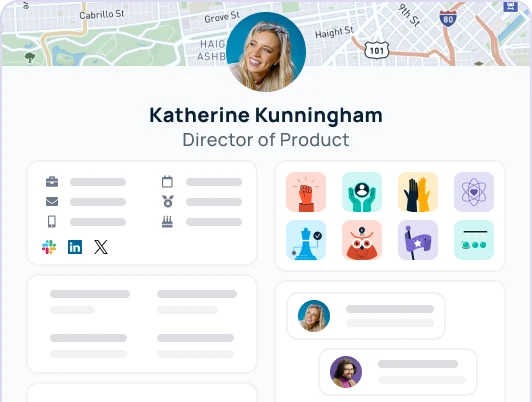What is the cost of disengaged employees?
We’ve all felt the impact when a coworker, supervisor, or direct report disengages from work. There’s more slack to pick up, more tension in the office, and less rapport between team members.
Sometimes, one employee’s disengagement is beyond anyone’s control. Other times, it’s a widespread result of poor management or bad company decisions – which means there are concrete ways to fix it.
But how exactly can you boost employee engagement?
It’s a million-dollar question – or more specifically, an $8.8 trillion-dollar question. That’s how much low engagement costs the global economy.

This article explores the cost of disengaged employees, including compelling stats that reinforce the need for better engagement in the workplace. We’ll suggest concrete ways to address the problem and motivate highly engaged workers.
The true cost of disengaged employees
Employee engagement surveys and research give us compelling numbers on the cost of disengaged employees. These stats reinforce that all successful companies – startups, enterprises, small businesses, nonprofits, highly profitable companies, and everything in between – should look to improve their employee engagement factors.
Here’s one way to calculate the cost of disengaged employees:
Past research suggests that actively disengaged employees cost about $3,400 for every $10,000 in salary (or 34%). If the average salary at your company is $65k, that means you’re annually losing $22,100 per disengaged employee. And that’s just the financial impact. Below, we outline other important outcomes tied to employee engagement.

Disengaged employee stats
Gallup’s research found that companies with high engagement outperform companies with low engagement across these key business metrics. Here’s how low-engagement companies fall behind:
- Workforce presence
- 81% higher absenteeism
- 43% higher turnover for low-turnover organizations
- 18% higher turnover for high-turnover organizations
- Employee wellbeing
- 64% more safety incidents
- 66% lower employee wellbeing
- Customer satisfaction
- 41% more quality defects
- 10% lower customer loyalty
- Company success
- 18% lower sales productivity
- 23% lower profitability
These numbers have a significant impact on workplace culture, brand perception, and customer experience. For instance, if low engagement causes 18% lower productivity, your company could suffer financially and lose investors’ confidence over time. Get a clearer idea of that impact by measuring remote employee productivity.
That lost productivity also impacts customer interactions. If a CS rep feels unmotivated, they’ll handle fewer customer complaints in a timely, helpful manner.

Addressing the disengagement problem
Getting rid of disengaged employees isn’t the solution. For one thing, the cost of replacing an employee can range from 0.5x to 2x their annual salary. In other words, a high turnover rate is expensive. Plus, layoffs damage the morale of more engaged employees.
Instead, you should focus on improving employee engagement by taking these proactive measures.
1. Bolster at-risk employees (“quiet quitters”)
Don’t let at-risk employees slip into active disengagement. This category includes “quiet quitters,” or people who show up but aren’t engaged. It’s a larger group than you’d expect – research indicates that over 50% of employees are quiet quitting.
To improve remote culture and reduce quiet quitting, try these digital employee experience ideas.
2. Train better managers
Managers are responsible for 70% of team engagement. So, any effective solution must include training for managers. Teach them best practices for supporting employees, assigning meaningful work, and building positive team culture.
3. Introduce recognition programs
Recognition plays an important role in engagement. In fact, great recognition causes a 20x increase in employees’ likelihood of being engaged. And if a business with 10,000 employees were to double employee recognition, it would see a 9% improvement in productivity. That’s around $92 million in gained employee productivity.
Streamline employee recognition with GoProfiles
GoProfiles is a people platform that fosters higher engagement, better management, and company-wide recognition. Its peer recognition feature lets employees award “Bravos” to teammates. These badges show appreciation for a job well done and make engagement easy. Managers can even use Bravo data to personalize praise or identify people at risk of disengagement.

These features make GoProfiles a great engagement solution:
- Peer recognition badges that surface publicly
- Company-wide map to indicate nearby coworkers
- Personalized employee profiles
- Org chart and directory
- Slack integration with automated anniversary and birthday shout-outs
- Team analytics and insights into company engagement trends
When the cost of disengaged employees is so high, GoProfiles is a no-brainer solution. Ready to cut that cost? Book a demo to learn how GoProfiles can help you create a culture of genuine recognition and engagement.

Cost of disengaged employees: FAQ
What strategies can organizations employ to identify and support “quiet quitters” or at-risk employees who are slipping into disengagement?
Organizations can employ several strategies to identify and support “quiet quitters” or at-risk employees slipping into disengagement, especially in remote or hybrid work settings. Some ideas include regular check-ins, surveys, or feedback mechanisms to gauge employee sentiment and identify signs of disengagement early on. Additionally, utilizing tools or technologies designed for remote team collaboration and communication can facilitate ongoing connections and provide opportunities for managers to offer support and encouragement to employees who may be struggling.
What are some pitfalls to avoid when introducing recognition initiatives, and how can organizations ensure the success of these programs?
Common pitfalls to avoid include lack of alignment with organizational values or goals, insufficient communication or training on how to effectively give and receive recognition, and failure to tailor recognition efforts to unique employee preferences. To overcome these challenges, organizations should ensure that recognition programs are transparent, inclusive, and integrated into the broader culture of the organization. Providing clear guidelines, regular feedback, and opportunities for employee input can help foster a culture of appreciation and ensure the long-term effectiveness of recognition initiatives.
What sets GoProfiles apart in terms of fostering genuine recognition and engagement?
GoProfiles offers features such as peer recognition badges, a company-wide map indicating nearby coworkers, personalized employee profiles, an org chart and directory, automated anniversary and birthday shout-outs in Slack, and team analytics to track engagement trends. What distinguishes GoProfiles is its user-friendly, AI-powered interface, seamless integration with popular communication tools like Slack, and focus on fostering a culture of appreciation and recognition in modern workplaces.








